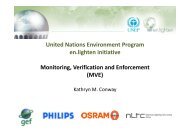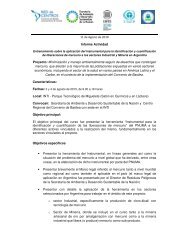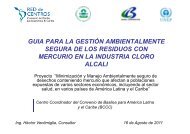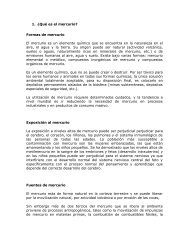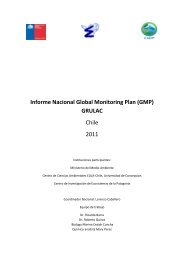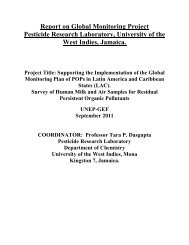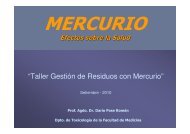Standard Operating Procedure for POP Sampling in Breast Milk
Standard Operating Procedure for POP Sampling in Breast Milk
Standard Operating Procedure for POP Sampling in Breast Milk
You also want an ePaper? Increase the reach of your titles
YUMPU automatically turns print PDFs into web optimized ePapers that Google loves.
<strong>Standard</strong> <strong>Operat<strong>in</strong>g</strong> <strong>Procedure</strong> <strong>for</strong><br />
<strong>POP</strong> <strong>Sampl<strong>in</strong>g</strong> <strong>in</strong> <strong>Breast</strong> <strong>Milk</strong><br />
Page 7 of 20<br />
5.6 Preparation of composite samples<br />
The samples must be handled by qualified personnel, to guarantee their <strong>in</strong>tegrity. Individual milk<br />
samples must be homogenized by heat<strong>in</strong>g them at 38 °C and shak<strong>in</strong>g them <strong>for</strong> 10 m<strong>in</strong>utes, after which<br />
the laboratory must prepare <strong>in</strong>dividual samples and composite samples. The <strong>in</strong>dividual samples must<br />
conta<strong>in</strong> 25 ml of breast milk <strong>for</strong> the analysis of analytically simple <strong>POP</strong>s, as pesticide <strong>POP</strong>s and PCB<br />
markers. As to the composite sample, 10 ml of each one of the 50 <strong>in</strong>dividual samples must be taken to<br />
obta<strong>in</strong> a 500-ml composite sample. Of those 500 ml, 50 ml must be kept aside <strong>for</strong> the analysis of simple<br />
<strong>POP</strong>s by the participant countries, and the rest, 450 ml, will be analyzed by the WHO Reference<br />
Laboratory. The latter will analyze both analytically simple and complex <strong>POP</strong>s, such as diox<strong>in</strong>-like PCBs,<br />
PCDD and PCDF. The rest of the sample collected from <strong>in</strong>dividual donors, (15 ml), must be mixed to<br />
obta<strong>in</strong> a 750-ml composite sample that will be sent to WHO <strong>for</strong> its Human <strong>Milk</strong> Global Bank. The Bank’s<br />
reserve will be used <strong>in</strong> the future if new <strong>POP</strong>s are added to the Stockholm Convention, as well as <strong>for</strong><br />
other scientific purposes. Countries with adequate resources may opt to obta<strong>in</strong> more than one<br />
composite sample from the 50 <strong>in</strong>dividual samples; <strong>for</strong> example, one composite sample obta<strong>in</strong>ed with 25<br />
<strong>in</strong>dividual samples. However, not all the composite samples need to conta<strong>in</strong> 500 ml. If the country<br />
wishes to analyze other contam<strong>in</strong>ants <strong>in</strong> aliquots of the composite samples, the protocol <strong>for</strong> sample<br />
collection will need to be modified accord<strong>in</strong>gly (either to <strong>in</strong>clude more donors or to <strong>in</strong>crease the volume<br />
of each milk sample). More <strong>in</strong><strong>for</strong>mation is available at the WHO Reference Laboratory.<br />
5.7 Laboratory test<strong>in</strong>g and analytical quality<br />
All the composite samples will be tested at the Laboratory <strong>for</strong> Diox<strong>in</strong>s and Agrotoxic Substances<br />
of the "Chemisches and Veter<strong>in</strong>äruntersuchungsamt Freiburg" (CVUA: Community Reference<br />
Laboratory <strong>for</strong> Chemical Test<strong>in</strong>g of Foods of Animal Orig<strong>in</strong>), <strong>in</strong> Freiburg, Germany. This laboratory was<br />
appo<strong>in</strong>ted as a WHO Reference Laboratory <strong>for</strong> the study, hav<strong>in</strong>g met all the requirements established by<br />
WHO at the Fourth Round <strong>for</strong> the Interlaboratory Calibration of PCDD, PCDF and PCB levels <strong>in</strong> human<br />
milk.<br />
The Reference Laboratory follows a rigorous quality control program to guarantee the accuracy<br />
and reliability of the results obta<strong>in</strong>ed <strong>in</strong> the study. The laboratory runs this program daily <strong>in</strong> the rout<strong>in</strong>e<br />
test<strong>in</strong>g <strong>for</strong> PCDD, PCDF and PCB and <strong>POP</strong> agrotoxics, primarily on foodstuff samples.<br />
The elements below are part of the quality program:<br />
Test<strong>in</strong>g of reagent blank samples;<br />
Test<strong>in</strong>g of <strong>for</strong>tified samples (ref<strong>in</strong>ed vegetal oil);<br />
Test<strong>in</strong>g of reference samples (known concentrations);<br />
The analytical procedures <strong>for</strong> the PCDD/PCDF and PCB will be per<strong>for</strong>med <strong>in</strong> accordance with<br />
the procedure described by Malisch and Leeuwen (2002) 1 . Follow<strong>in</strong>g freeze-dry<strong>in</strong>g, the sample will be<br />
extracted with ethanol/toluene (70:30, v:v) <strong>for</strong> 8 hours <strong>in</strong> a "Twisselmann" extractor. The raw extract,<br />
primarily consist<strong>in</strong>g of fat, will be purified with ether and <strong>for</strong>tified with PCDD/PCDF and PCB <strong>in</strong>-house<br />
standards labeled with 13 C. The fat from the extract will be removed us<strong>in</strong>g gel permeation<br />
chromatography (Bio Beads S-X3). After treat<strong>in</strong>g the extract <strong>in</strong> a multilayer column (silica, silica/sulfuric<br />
acid), the PCDD/PCDF and PCB will be separated <strong>in</strong> a Florisil column. The PCDD/PCDF fraction will be<br />
treated <strong>in</strong> an activated charcoal column and later analyzed <strong>in</strong> a High Resolution Gas Chromatographer<br />
1 Malisch, R; Leeuwen FXR. (2002). Organohalogen Compounds 56, 317-320.





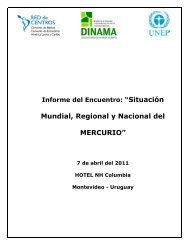
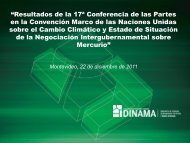

![COP_aire [Compatibility Mode] - Centro Coordinador de Basilea ...](https://img.yumpu.com/44106171/1/190x134/cop-aire-compatibility-mode-centro-coordinador-de-basilea-.jpg?quality=85)
